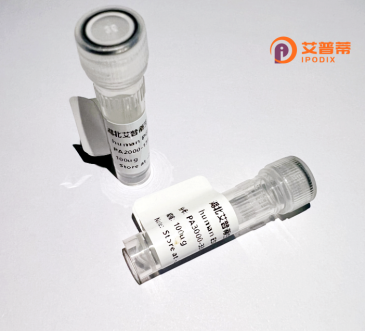
| 纯度 | >90%SDS-PAGE. |
| 种属 | Human |
| 靶点 | RPS15A |
| Uniprot No | P62244 |
| 内毒素 | < 0.01EU/μg |
| 表达宿主 | E.coli |
| 表达区间 | 2-130 aa |
| 活性数据 | VRMNVLADA LKSINNAEKR GKRQVLIRPC SKVIVRFLTV MMKHGYIGEF EIIDDHRAGK IVVNLTGRLN KCGVISPRFD VQLKDLEKWQ NNLLPSRQFG FIVLTTSAGI MDHEEARRKH TGGKILGFFF |
| 分子量 | 14.8 kDa |
| 蛋白标签 | His tag N-Terminus |
| 缓冲液 | PBS, pH7.4, containing 0.01% SKL, 1mM DTT, 5% Trehalose and Proclin300. |
| 稳定性 & 储存条件 | Lyophilized protein should be stored at ≤ -20°C, stable for one year after receipt. Reconstituted protein solution can be stored at 2-8°C for 2-7 days. Aliquots of reconstituted samples are stable at ≤ -20°C for 3 months. |
| 复溶 | Always centrifuge tubes before opening.Do not mix by vortex or pipetting. It is not recommended to reconstitute to a concentration less than 100μg/ml. Dissolve the lyophilized protein in distilled water. Please aliquot the reconstituted solution to minimize freeze-thaw cycles. |
1. **《RPS15A promotes malignant transformation and progression of glioma via reeducating tumor-associated macrophages》**
作者:Zhang et al.
摘要:探究RPS15A在胶质瘤中的致癌机制,发现其通过激活特定信号通路重编程肿瘤相关巨噬细胞表型,从而促进肿瘤进展,为靶向治疗提供新思路。
2. **《Recombinant human RPS15A induces colorectal cancer cell apoptosis via a mitochondria-dependent pathway》**
作者:Wang & Li
摘要:研究重组RPS15A蛋白在结直肠癌细胞中的促凋亡作用,表明其通过线粒体途径激活Caspase级联反应,抑制癌细胞增殖。
3. **《Ribosomal protein S15A regulates cellular senescence through p53-p21 signaling in breast cancer》**
作者:Kim et al.
摘要:揭示RPS15A通过调控p53-p21通路诱导乳腺癌细胞衰老,重组蛋白的过表达可抑制肿瘤生长,提出其在癌症治疗中的潜在应用。
4. **《Proteomic analysis of RPS15A interactome identifies novel binding partners in mRNA translation regulation》**
作者:Gupta et al.
摘要:利用重组RPS15A蛋白进行互作组学分析,发现其与多个翻译起始因子相互作用,揭示其通过调控mRNA翻译精确性影响细胞蛋白质稳态的新功能。
Ribosomal protein S15a (RPS15A) is a conserved component of the 40S small ribosomal subunit, essential for mRNA translation in eukaryotes. It plays a structural role in ribosome assembly and stabilizes interactions between rRNA and other ribosomal proteins. RPS15A also contributes to the decoding center, influencing translation fidelity and efficiency. Beyond its canonical role, studies suggest non-ribosomal functions, including interactions with non-ribosomal proteins and involvement in DNA repair pathways.
Recombinant human RPS15A is produced using expression systems like *E. coli* or yeast, enabling biochemical and functional studies. It typically retains post-translational modifications when expressed in eukaryotic systems, critical for its activity. Research highlights its dysregulation in cancers (e.g., colorectal, breast) where overexpression correlates with tumor progression and poor prognosis, potentially serving as a biomarker or therapeutic target.
Additionally, RPS15A mutations have been linked to ribosomopathies and developmental disorders, emphasizing its biological importance. Structural studies reveal a compact globular domain with RNA-binding motifs, conserved across species. Investigating recombinant RPS15A aids in elucidating ribosome biogenesis mechanisms, disease pathways, and therapeutic opportunities. Its dual role in translation and cellular stress responses makes it a focal point in studying ribosome-mediated health and disease processes.
×